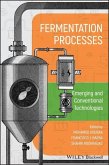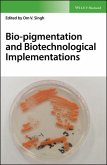MICROBIAL FERMENTATIONS IN NATURE AND AS DESIGNED PROCESSES
Fermentation is one of the most important metabolic tools that biology has developed and microorganisms in many ways seem to have become the true masters of fermentative metabolism. Each of the fermentative microbial functions evolved to fit an energetic opportunity, and each function has ecological value.
This book provides its readers with:
_ Understanding regarding the commonalities and distinctions between aerobic and anaerobic fermentations as performed by microorganisms.
_ A summary of knowledge regarding the ways in which animals and plants depend upon symbiotic interactions with their fermenting microbial partners including the deconstruction of complex polysaccharides. Information is also included about how those natural technologies constitute adaptation into designed processes for anaerobic degradation of lignocellulosic materials.
_ The important role of rhizosphere microbes that facilitate availability of inorganic and organic phosphates for plants. These phosphates get stored in the plant's seeds. After ruminant animals ingest the seeds, enzymes produced by gastrointestinal microbial fermentation allow the animals to utilize their dietary phosphates.
_ History of how microbial fermentation has been harnessed from prehistoric times to the present for processing and preserving food products for humans and fodder for our domesticated animals.
_ Insight into the ways that microbial fermentations are used as an engineering tool for producing chemicals, including enzymes and pharmaceuticals, which improve the health of ourselves and our domesticated animals.
_ Perspectives on possible future research directions for the field of applied microbial fermentation that will help to advance agriculture and industry.
Hinweis: Dieser Artikel kann nur an eine deutsche Lieferadresse ausgeliefert werden.
Fermentation is one of the most important metabolic tools that biology has developed and microorganisms in many ways seem to have become the true masters of fermentative metabolism. Each of the fermentative microbial functions evolved to fit an energetic opportunity, and each function has ecological value.
This book provides its readers with:
_ Understanding regarding the commonalities and distinctions between aerobic and anaerobic fermentations as performed by microorganisms.
_ A summary of knowledge regarding the ways in which animals and plants depend upon symbiotic interactions with their fermenting microbial partners including the deconstruction of complex polysaccharides. Information is also included about how those natural technologies constitute adaptation into designed processes for anaerobic degradation of lignocellulosic materials.
_ The important role of rhizosphere microbes that facilitate availability of inorganic and organic phosphates for plants. These phosphates get stored in the plant's seeds. After ruminant animals ingest the seeds, enzymes produced by gastrointestinal microbial fermentation allow the animals to utilize their dietary phosphates.
_ History of how microbial fermentation has been harnessed from prehistoric times to the present for processing and preserving food products for humans and fodder for our domesticated animals.
_ Insight into the ways that microbial fermentations are used as an engineering tool for producing chemicals, including enzymes and pharmaceuticals, which improve the health of ourselves and our domesticated animals.
_ Perspectives on possible future research directions for the field of applied microbial fermentation that will help to advance agriculture and industry.
Hinweis: Dieser Artikel kann nur an eine deutsche Lieferadresse ausgeliefert werden.








